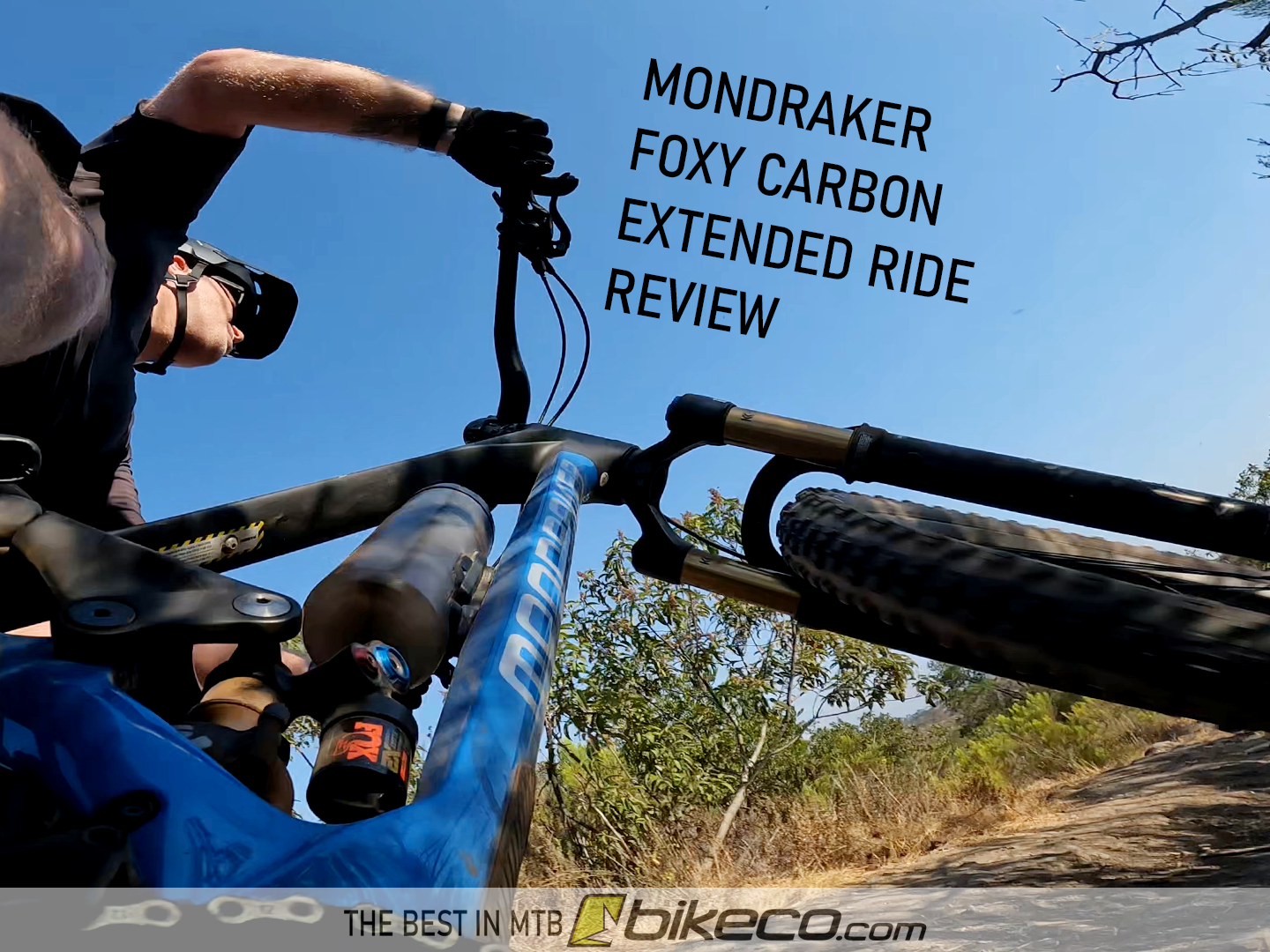
Well, I’ve put in some really enjoyable months and miles on my FOXY Carbon so, it’s time to put down my Mondraker FOXY carbon Review: Extended Ride.
The abridged version: I love this bike and build. Love it.
The FOXY Carbon is confident, predictable and it pedals amazingly well for what I would have considered a long travel 29er. Long travel compared to my previous SB130 Lunch Ride? Ya, I know we’re talking like 10mm in the fork and maybe 13mm in the rear – but we can get more into that down the trail.
For this review I think I’ll hit first on the “heart” of the FOXY – geo and suspension performance and then circle back onto the individual parts on my build as some of them are new to me on an extended review.
Mondraker FOXY Carbon Review Series!
This is the latest in a series of content focused on my Mondraker FOXY experience. You can learn more about how I’ve come to the conclusions here on the Mondraker FOXY Carbon review going through the timeline of posts here on BikeCo.com
Mondraker FOXY “First Ride” Review
Walk through the original setup and thoughts on my build!
Comparing the FOX Grip and Ohlins RXF forks
What led me away from the Ohlins and back to FOX? Check it out
Extra FOXY Mondraker: Foxy with 170mm Fox 38 and Float X2
The real start of my love affair with this bike…
Keep reading / watching for the latest on the Mondraker FOXY below!

The FOXY at home on a quick chunky loop in La Costa Preserve. Keeping your handlebar a bit taller will help provide a “power” position to push the bike through steep and chunky sections.
Mondraker Forward Geometry
This Mondraker Forward Geo branding launched several years ago. Mondraker was one of the first in the Longer, Slacker, Lower geometry that ended up taking the entire industry.
The longer bikes, shorter fork offsets, increased trail measurement all gave bikes notably more performance without ultra slack headtubes which compromise steering and direction changes.
In today’s marketplace the Mondraker geometry isn’t as “far forward” comparatively to competitive bikes but they are on the longer side of top tier manufacturers. For instance, I had been debating if my Large SB130 might be just a bit short and was debating about an XL. With the longer top tube on the FOXY I stayed in a Large but got the bit of extra length I was looking for.
As a sizing reference I’m 6’1” with long limbs about a 35” inseam and 76” fingertip to fingertip. This allows me to ride the Large using stems in my preferred range of 40/45mm. (you’ll note that’s right in the range of a modern 29 fork offset – I think there’s something to that but haven’t penciled out “why” to date)
Going back to the concern of a “bigger bike”: Was the slightly slacker headtube my FOXY had compared to the Lunch Ride going to create issues climbing or in less steep terrain?
Initially I rode the bike with the stock 160mm Ohlins fork which had its issues, but not in terms of geometry or headtube. The 160mm bike was well planted and didn’t wander even climbing in technical sections.
After moving away from the Ohlins I went slightly slacker with the 170mm FOX 38 fork. To date I haven’t noticed any issues even with the taller fork. The bike climbs well, tracks through steep switchbacks uphill and gets onto and over rocky sections well. Sliding a bit forward on some sections will help you stay in a position where you can easily add extra load through the grips if the front end feels a little light to you.
I left the flip chips in the stock position with the shorter chainstay measurements. The bike works so well I haven’t really felt like meddling with it – maybe one of these days, but I feel like the bike is slack enough especially with the longer fork which also raises the bottom bracket just slightly (similar to what the flip chips would do).
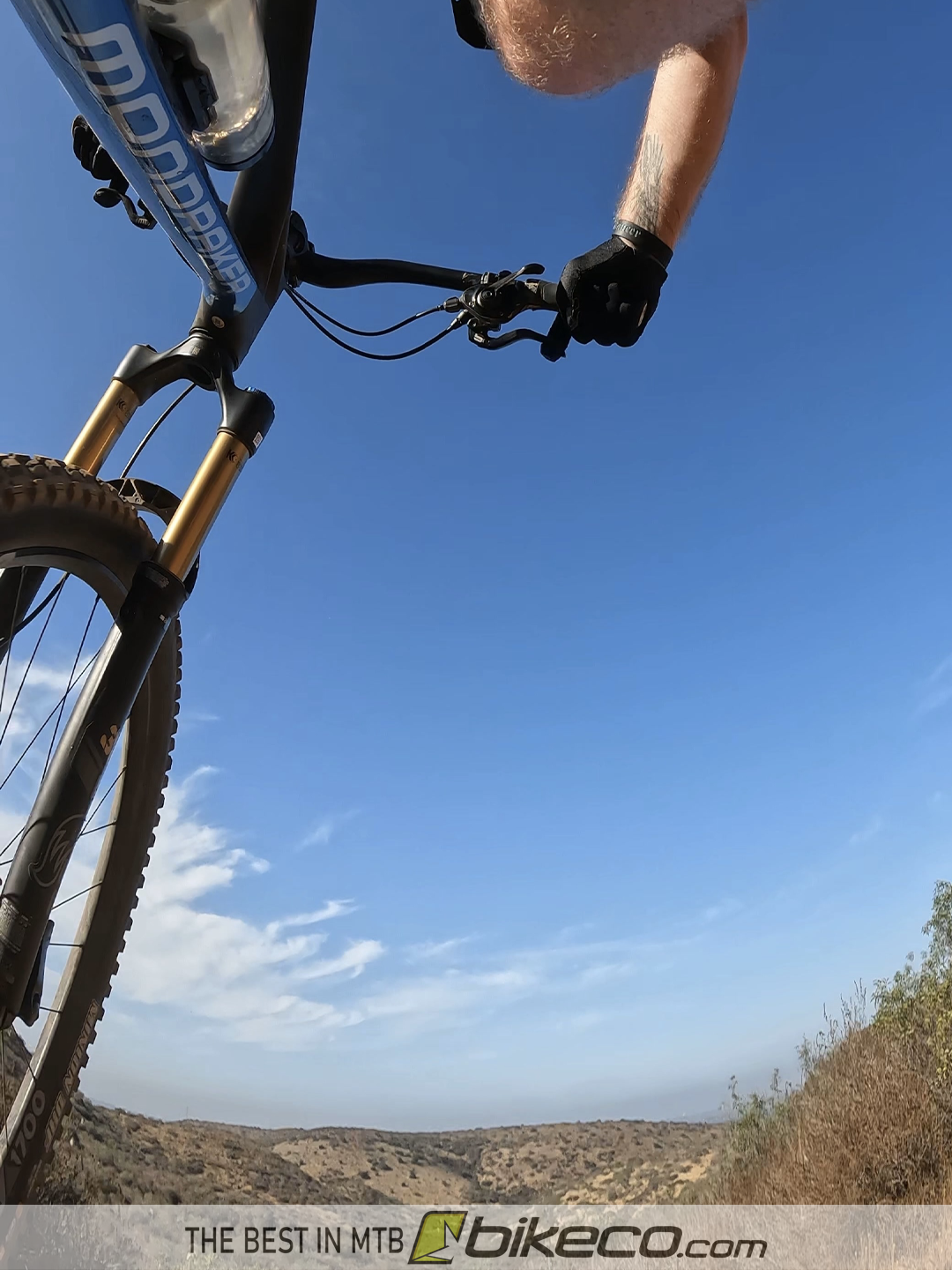
I love bikes with long, straight, mean lines. The FOXY’s front triangle features a unique thin but wide top tube to maximize strength and trail compliance. It looks fast on trail or sitting in my office! Mission Trails in San Diego
Mondraker ZERO Suspension
Like the fork I ended up going back to FOX on the rear shock – I’ve got another write up on that (in short as a heavier rider the Ohlins was overwhelmed, but I know lighter riders who love it) – but after that switch what are my thoughts? ZERO complaints…
What’s so special about the Mondraker ZERO Suspension design?
Well, a lot of work goes into balancing MTB suspension. Over-simplified: You’ve got to take into account how the wheel arcs, what it does to the drivetrain, what’s the leverage ratio overall, how does the sine angle change the leverage input on the shock? Rising rate mechanical leverage? Falling rate? Mixed? How does that mesh with the shock you’ve spec’d ramp rate? Damping capacity?
A lot of designs “look” similar – but the details simply aren’t that easy to replicate, either from the physics and math or the patents.
Unlike Geo, which has converged into a pretty similar realm depending on what level of bike you’re shopping, ie enduro, trail/enduro, trail, endurance/XC – look alike suspension isn’t a thing you can simply look at what the industry leaders are doing and say ya, I’ll take some of that and slap it on your design…
I’ve been riding a lot of years at this point. I’ve ridden tons of designs. I’ve owned most of the best. (last two bikes were an Ibis HD with DW Suspension and the Yeti SB130 with Switch Infinity Suspension – DW is plush and planted, Switch is poppy and fun). That said, the FOXY is my first bike with floating suspension.
The Mondraker ZERO mounts each side of the rear shock onto pivot linkage creating a “floating” design. This has a couple interesting advantages for designers to work with. Particularly the angle of input into the shock (which changes the mechanical leverage ratio through the spring’s ramp rate to give a bike the designed balance).
What’s this mean? Floating suspensions are known for being compliant. Mondraker Zero suspension takes that compliance and adds an efficient pedaling platform able to keep the bike planted and efficient under power. The FOXY’s suspension suspends and the drivetrain drives without one interfering with the other. It’s designed to have ZERO “cross contamination” if you will.
What’s that mean on trail?
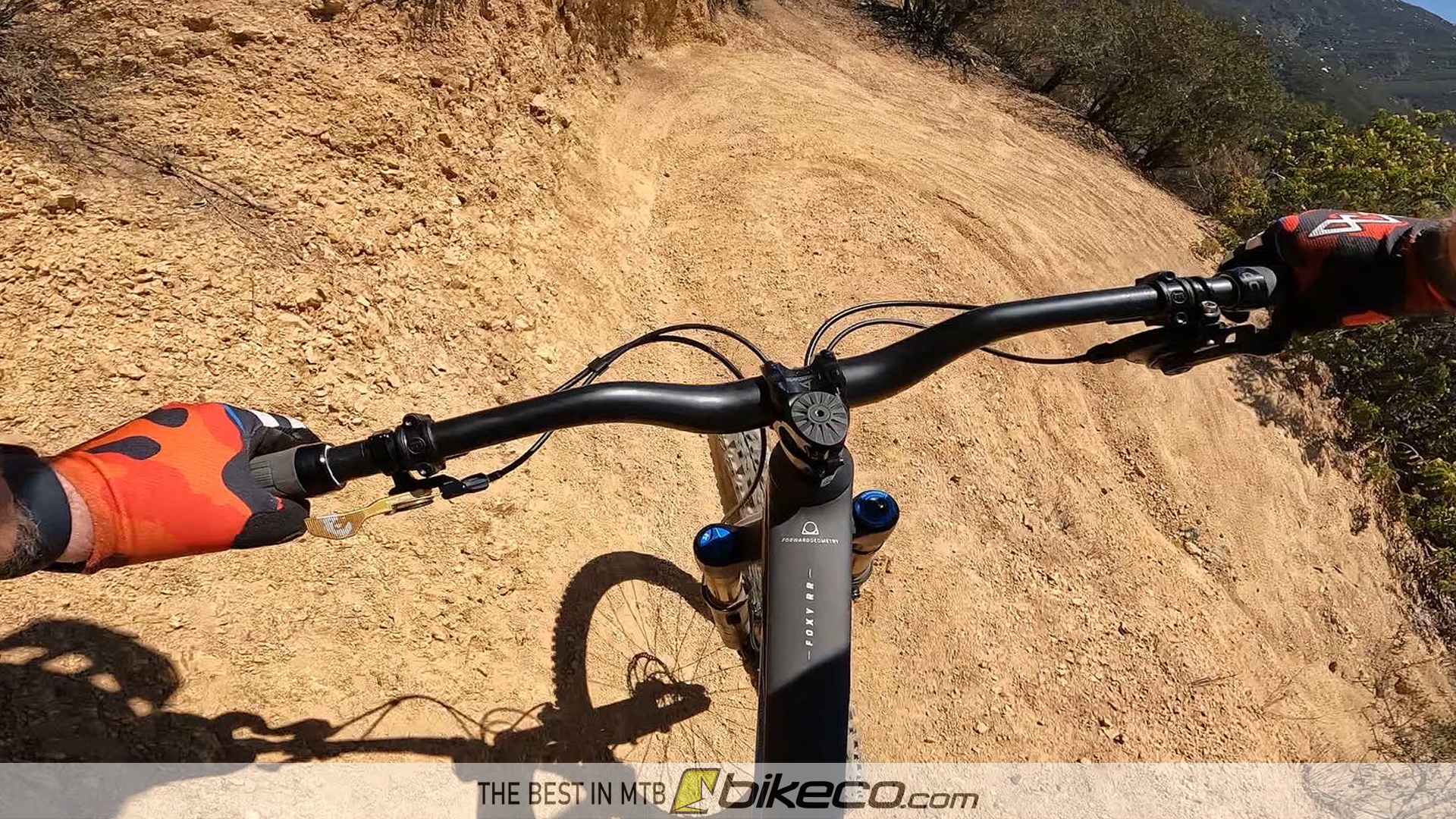
One of the places I’ve been most impressed is how well the “longer” FOXY gets through the tight stuff both uphill and downhill. This bike is easy to maintain control of both the front and rear wheel in a “normal” range of riding positions.
ZERO Suspension Uphill
The FOXY is the first bike I’ve owned that I don’t use the shock’s climbing “lock-out”. That’s a really interesting fact. The Mondraker climbs well enough I don’t feel like I need that additional compression setting. It doesn’t suffer bob, it doesn’t feel like it’s sitting too deep when you get headed up the steeps and weight shifts backwards.
Keeping the shock “open” provides another advantage when climbing the Mondraker – it increases the bike’s available traction climbing technical sections.
My FOXY is the best climbing bike I’ve owned. It has incredible traction – it doesn’t spin wheels (which I HATE as it hurts my lower back when bikes have that power on, off, on kick), it’s efficient – add power and the bike accelerates, and likely because I’m able to climb it in the shock’s open position the bike doesn’t have the reverse “pop” or kick back that other bikes might have when climbing up and over chunky rocks, etc.
Previously I had to be ready to really attack a rock face, and as a less fit rider that’s not always as easy as it sounds!
Riding the FOXY, even at lower power input, the bike uses all that traction and churns up and over . This eliminates the “popping” back and needing that extra momentum from explosive pedaling. Now, some of this might be from some the drivetrain setup as well and I’ll come back to that in the spec review.

Leaning into the corner on San Juan Trail off Ortega. Since most of my riding isn’t in the gnarliest stuff it’s important to me a bike is fun on the flatter, faster stuff while having enough in the tank to tackle chunkier terrain too. The Mondraker FOXY checks that box – riding incredible for a 170mm front (modified from 160 stock) and 150mm rear Enduro bike.
Downhill – ZERO Complaints.
It’s interesting jumping on different bikes and feeling out how they want to behave and what they want from rider input.
I’m looking for a pretty specific feel downhill.
What does it take to control both wheels? I want a bike that in a range of normal riding positions I can get traction off both the front and rear wheel when I want it. Running VPP bikes it felt like you were hard pressed to control the front and rear wheel . Riding them fast particularly in fast corners it seemed like you had to choose whether to ride off the back and really drive through with your feet and hips or pushing the front end to hook up and almost “unicycling” through the corners. I think this hindered my riding for a long time until I got onto other suspension designs that allowed me to comfortably corner faster knowing I was basically doubling my traction…
I prefer bikes that “pop” when pumped on the trail. It’s a fun feel and gives you the ability to find “free” speed. The trick is finding suspension designs that offer that feel without compromising on the total traction and compliance. How much Pop versus Thump – like a bike with too much pop won’t allow you to power through terrain without feeling like you’re on a pogo stick. A bike with too much thump may feel numb until you get it up to speed (my last 26″ bike suffered terribly from that – it wasn’t fun until it was going soooo fast…)
My bikes need to balance compliance, support and ramp rate. I’m willing to trade some compliance (as I can find some in tires, etc) but the balance of support and ramp is important. Having a bike with enough support to corner fast or stay tall in the steep and chunky stuff is critical for a confident experience.
As another note on balance – and it’s not been a problem on any bike I’ve owned, but I’ve found it on some test bikes over the years: if the rear end can’t be balanced to the front it’s just not worth riding! Something else to think about when you see “look-alike” suspension…
Back to the FOXY Carbon Review: Mondraker Suspension has ZERO compromises and I have ZERO complaints (after setting it up with the dampers that accommodate my weight and ground speed)
The FOXY has a wide range of ground speed where its “lively”. I’ll use the word lively, I suppose I mean it changes direction with minimal input, kind of that floating or flying feel that I love in MTB.
It’s also a comfortable when you get going and start to find the limits. The bike is predictable and confident. The FOXY has a “soft” speed limit – meaning that it eases into the point of losing traction or being overwhelmed. It will give you some time to know, hmmm I need to get ready for a 2 wheel drift or the bike to start smashing travel. This is advantageous over bikes with a “hard” speed limit which hit the end of capacity quickly and don’t give riders as much time for correction.
I’ve had it in slower speed, chunky, consequence riding conditions and the FOXY is really sure footed. The suspension absorbs what it needs without jarring you back off the other end as the shock rebounds.
The FOXY is really good at holding a line at a wide range of speeds and terrain.
Where does the bike shine brightest? Well, push that bike into fast, burly stuff and it just begs for more. Makes sense for an EWS level Enduro bike right? Yup.
The FOXY manuals well, jumps better than I do and is easy to control both front and rear wheels.
With the taller front end, between both fork travel and cockpit setup, I can control the front end in steeps as I don’t have to ride way way off the back wheel.
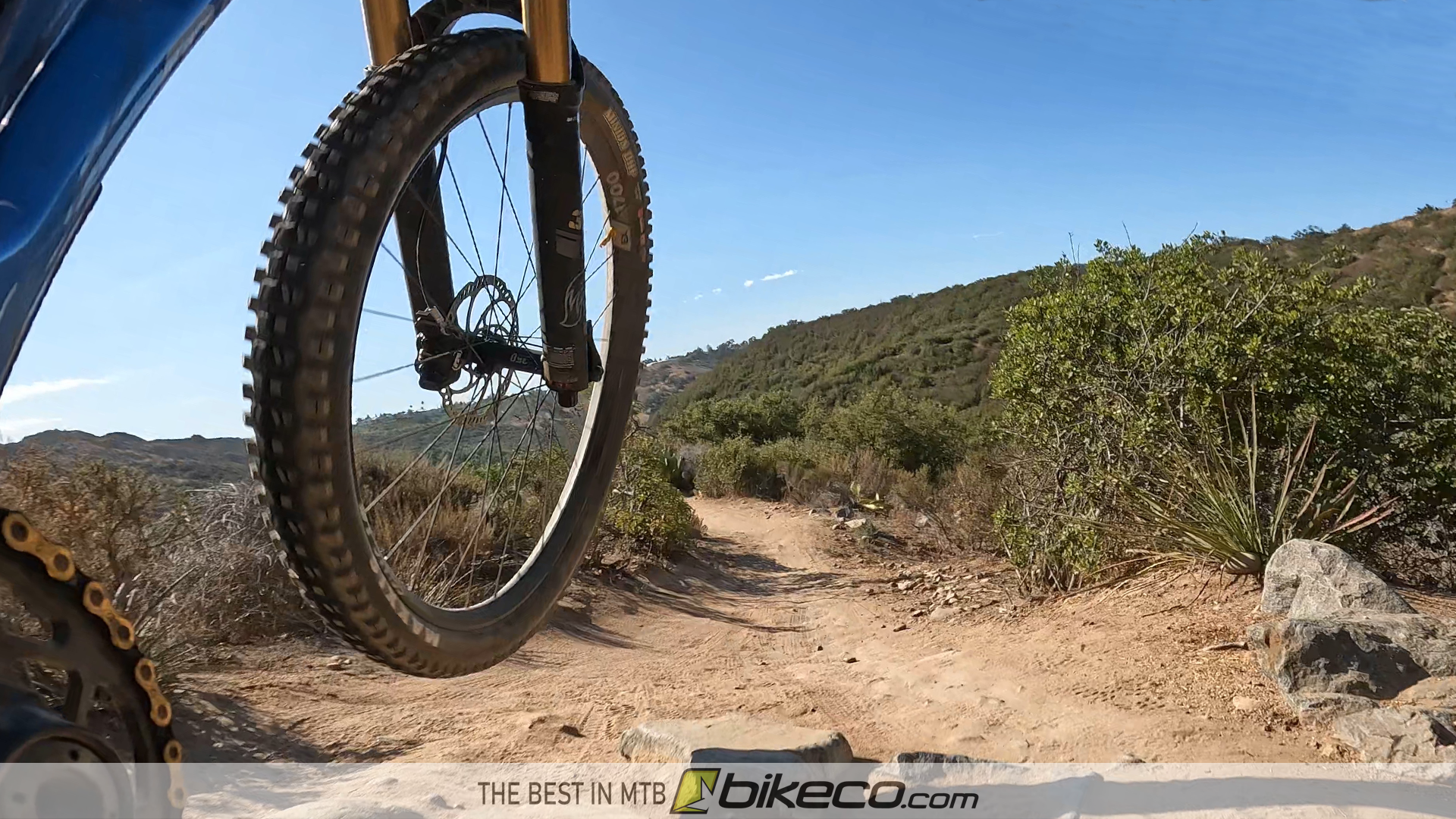
Modern MTB bike spec from industry leaders like Ibis, Mondraker and Yeti are great starting points. Want to take your performance a little further? Chat with our team about how a part here or there will fine tune your bike’s personality. Morning ride before work in Whiting Ranch.
Semi-Custom Mondraker FOXY Carbon Review: My Spec
So let’s get this on the table – I buy all my parts. So, if you see it on my bike, I believe in it and I want it on my bike.
BikeCo has a similar feeling as a business – we offer the best in MTB for a wide range of riders and a wide range of preferences. I’m not saying my spec is the absolute for everyone because a lot of preference goes into spec.
In the spec review I’m going to let you know if its new to me, some thoughts and opinions.
Suspension
FOX 38 GRIP2 Fork, 170mm
I’ve run the GRIP2 as long as it’s been around, but in the 36 160mm fork. The 38 chassis is new to me. I wondered if I would notice the “heavier” front end but I haven’t. The 38 features bleed valves meaning I’ve lot one of my favorite tips and tricks of burping and lubing seals! I never noticed the 36 having any flex issues for me, but the 38 will have even less theoretically…
Float X2 Rear Shock
This is THE shock. It’s been several years since I’ve run the X2 and I did like the SB130’s DPX2 (probably would have loved an X2 on that bike BTW but never made it happen between pandemic availability, etc, etc). The X2 is literally the most special shock I’ve ridden. When setup correctly the high and low speed compression on the X2 provide unbeatable control. In my opinion better than even the computer controlled shocks. Splitting low speed and high speed compression means you can have a shock that offers a lot of pedaling support, but has the ability to instantly open from a small weight shift to prepare for your descent. The X2 is tuneable with air pressure, volume spacing, and both high and low speed compression and rebound.
Getting the suspension setup right allows your bike to float where it needs to float, support where it needs support. BikeCo Pro Tunes take the FOX performance window and narrow it to a particular rider’s weight, ground speed, terrain, and abilities.
Suspension support is important as your ground speed increases and you ride in bigger terrain. There are a lot of ways to work on this and compression setup or PSI (sag) are typically the first you’ll look at. But, no one wants a bike that rattles your teeth out right? So where do we find more small bump compliance to make up for the stiffer suspension? Tires.
Tires
2.5” Maxxis Minion DHF EXO+ 3C MaxxTerra front
2.4” DHR II EXO+ 3C MaxxTerra rear
Love the original Mondraker spec. I’ve run these tread patterns on a bunch of my bikes over the years. This is the first time I’ve run the EXO+ on the front. I was a little concerned about adding weight to the front of my bike and how much it would change the amount of input needed for turning or manualing the bike. Haven’t really noticed it.
The EXO+ gives good support allowing me to maximize, err, well I suppose minimize the air pressures I run. Getting your PSI right means balancing grip with support in high load corners or terrain.

The Mondraker name is building in the USA but it’s been a staple in World Class racing in Europe for ages now. More than a sexy euro trailer queen the Mondraker lineup has proven it can provide riders trail experiences parallel with the top tier expectations from any brand in MTB.
Wheels / Rims
DT Swiss 350 hubs, straight pull spokes on EX 1700 rims
I’ve run DT 350 stock builds before although this is the first time with straight pull spokes and the smaller diameter hubs.
I love the EX1700 rims 30mm internals. It’s my favorite inner dimension as it gives a great shape to the typical 2.4/2.5” tires that most enduro or trail/enduro riders enjoy. I tend to ride pretty hard particularly on the rear wheels. The EX1700 have stayed true and have taken a pretty good beating. I haven’t put any rim protection on these wheels either. Oh, and they mount tires easily – which – on your own bike isn’t necessarily that big of a deal but helping at the shop I mount a lot of tires on a lot of wheels. It’s always a little easier to see those rims in my pile of work to do!
This is my first go around with straight pull spokes. No real input on that yet. I prefer J-bend for a lot of reasons we’ll see if I find my reasons justified or not over some time I suppose.
DT Swiss 350 hubs. I’ve had good luck with my last set of DT hubs. This might be set 3 for me but I can’t remember for sure. What I’ve learned about DT Swiss 350 hubs over the years:
First, the driver isn’t “fixed” onto the hub. Makes it super easy to service or mod parts. BUT! When you mount tires and are thumping them to slosh the tire sealant around MAKE SURE you have the cassette up and have a hand on it. I make this mistake about once a year. Mount a tire, banging the wheel and cassette, ratchet system and springs are all over the floor!
I run the 36t ratchet. The 18t feels clunky and the 54t is delicate in my opinion, not something I need as a heavier rider with poor pedaling technique.
This is my first go at the smaller diameter and smaller spoke flange design. I do notice that in really hard corners I can hear the front rotor “tinging” suggesting that there’s some flex somewhere. But, as long as it’s not leading to premature wear or failure it’s not a big deal to me at the moment. Makes you feel kinda cool like ya, that’s a corner. Haha…

Another morning ride in Whiting Ranch before work. What other sport consistently gets the views we get in MTB??
Drivetrain
I tend to run GX level drivetrains. I find the performance / value is hard to beat. I think that the XX1 and X01 likely has a slightly longer service life though. A well lubed SRAM drivetrain’s service interval overall is pretty much impossible to beat in my experience.
SRAM GX 10-52T Cassette (pinned)
This is my first 52t cassette. I find it’s a really notable bail out gear from the 48t – however – it does feel like a big shift so I don’t want to dump shift into it as I’m sure that’s hard on it. I could see a lot of riders preferring the 50t option if they’re strong climbers. I prefer the extra little bit available with the 52t so far.
KMC X-12ti Chain
While I run GX level bits I do spend a bit more on the chain. Typically I run XX1 chains as I feel like the surface conditioning as well as manufacturing techniques give better performance longer than the less expensive chains. On this bike I put the KMC X-12ti on as I wanted the gold highlights to remind me of my daughter’s cancer fight (gold is the universal kid cancer color fyi – we’ve got it removed and 6 months of clear scans so life’s good).
AbsoluteBlack Oval Chainring
The AbsoluteBlack Oval chainring is the first oval I’ve ridden more than say twice in a row. I’ve gotten used to it and really don’t feel it anymore. When I first rode it I felt like it was more notable as the leverage changed through the stroke. Since I’m kind of a churny climber I feel like the oval ring does give me some advantage. If you’re spinning high cadence it might feel a little funny. Setting up the Mondraker chainguide was a bit of a compromise but I haven’t had any issues dropping the chain thus far with the setup.
SRAM GX Alloy Cranks, 175mm
These new GX cranks are really, really nice in my opinion. They look good and are pretty light given their position in the SRAM Eagle lineup. I run 175mm cranks. I used to have a more distinct opinion on who should ride what – but then I measured 5mm. It’s like three quarters stacked on top of each other. Run what you want! I’m not sure that distance is causing or negating any pedal strikes for me…
RaceFace Atlas Pedals
The Atlas pedals have made it to either their third or fourth bike. Maybe this is the third. But, considering that they’ve been in service since Nov 2018 for a bigger rider without a rebuild – got my value out of those…
Seating
Ergon SM Enduro Men’s saddle
I can’t recall if I’ve run this exact Ergon saddle before. I ride Ergon saddles as they tend to have a comfortable balance between the seating area and the relief areas. I typically don’t notice them. Which is my goal with saddles.
175mm FOX Transfer post
Wondering if I want to go to the 200mm – not because I need any more drop when riding, but with the taller BB height compared to my last bike I can’t quite flat foot the bike getting on and off. Maybe I’m getting older and my leg doesn’t go as high when I kick over?
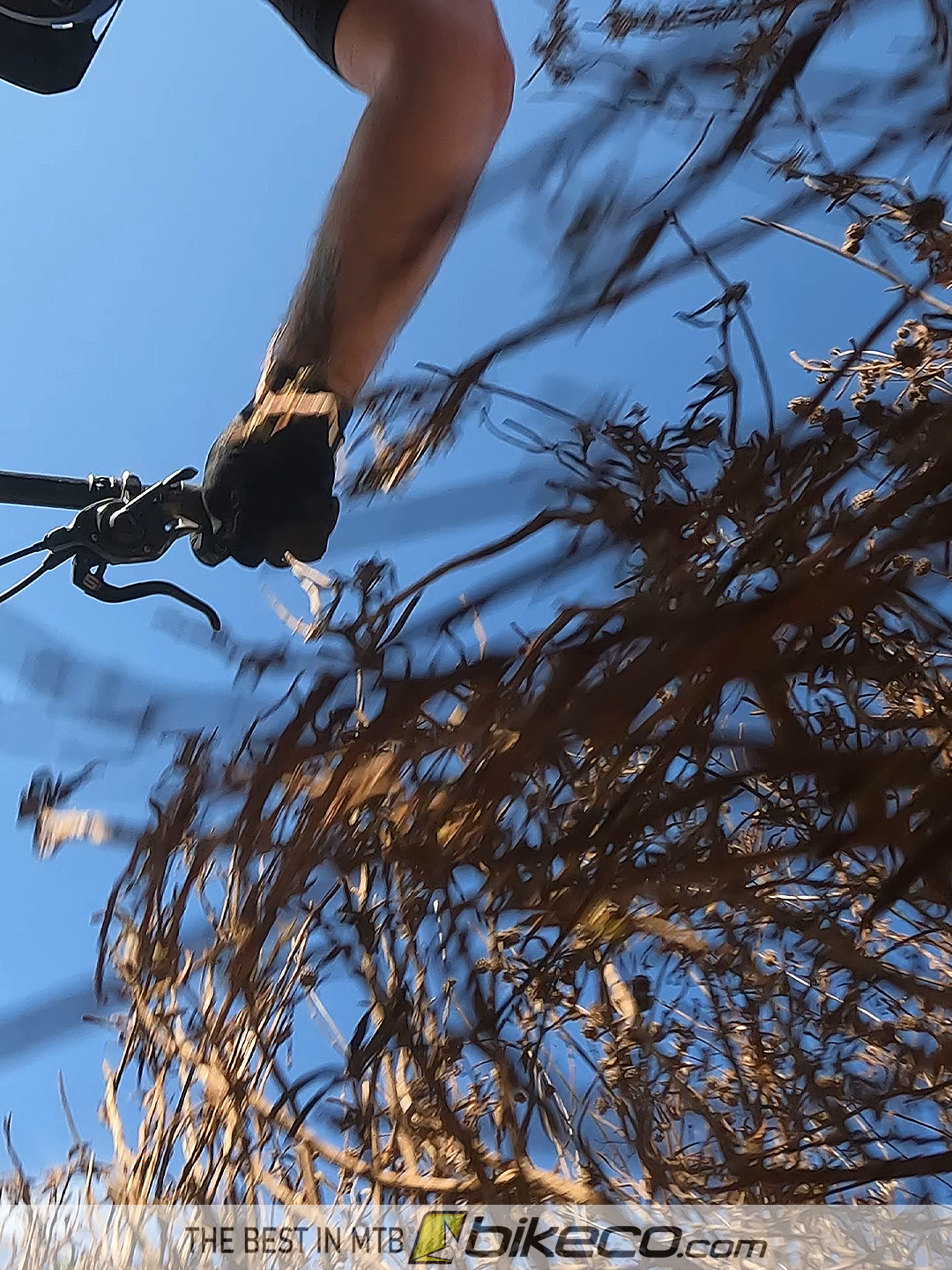
One of the tricks to spec’ing your dream bike: knowing where you can find extra performance at a great value. Magura MT5 brakes work excellent balancing unbeatable modulation and power. With a proper first bleed these brakes will work amazing with just an occasional bubble bleed for years.
Cockpit
Wolf Tooth Light Action Remote
I’ve been running these for several years too. I prefer the longer lever Light Action since it requires less force, although it does need further throw, to activate. I have bad hands and every little bit helps.
Ergon GE1 Evo Grips, Regular Diameter
I’d run WTB padloc grips for years – but – they seem to be a casualty to covid. So, I went beack to the Ergon GE1 Evo. They have some of the additional padding at the edge which was my favorite aspect of my previous grips. The GE1 grips are left and right specific and have a designed shape for improved ergonomics. With a single inner clamp they don’t need the raised outer edge required for a second clamp, which I absolutely hate the feel of. I tend to run my hands slightly off the grips and that rise hurts. The one complaint on the Ergons is they are slippery when wet. I climb without gloves and I have to be aware on any quick descent or whatever to wipe them well or the sweat makes them really slick. Gloves solve this so they’ve stayed on the bike so far.
RaceFace Turbine-R Stem 40mm
I’ve been running this stem since it was labeled Easton before the buyout! It’s an elegant shape with a nice finish but most importantly it was one of the first stems to come out machined flat at the top, so you tighten the faces together there and then torque the bottom bolts. I love attention to detail.
Tag T1 Carbon Bars, 40mm rise stock 800mm width
I went with the Tag T1 Carbon Bars as I like the concept of the ovalized design to fine tune and help damp trail vibration. It’s not something that you’re going to be like oh, I feel it so much – but every little bit helps. Some bars speed handling, typically not what I’m looking for at speed while others can slow handling (didn’t need it on this bike). The Tag sits in the middle as a neutral option.
Magura MT5 Brakes, 180mm HC Rotors
Figured I’d close with these. If you’ve read much of our stuff you’ve come across my love for Magura brakes. Unbeatable power and modulation (although, I’m told the new Hope V4 have brought more power to the Hope options which also have great modulation). I love the stock lever on the MT5 which is slightly longer adding to the modulation feel (like the seatpost remote – longer lever = longer throw to full engagement which translates to more modulation on brakes). Even as a larger rider I run 180mm rotors unless its really a big day or trip. I find the balance is good although more and more riders are setting up in the 203/180 or 203/203 range.
Hope you learned something in this Mondraker FOXY Carbon Review! Geo, suspension on trail personality and a bit on the what’s and why’s of my spec!
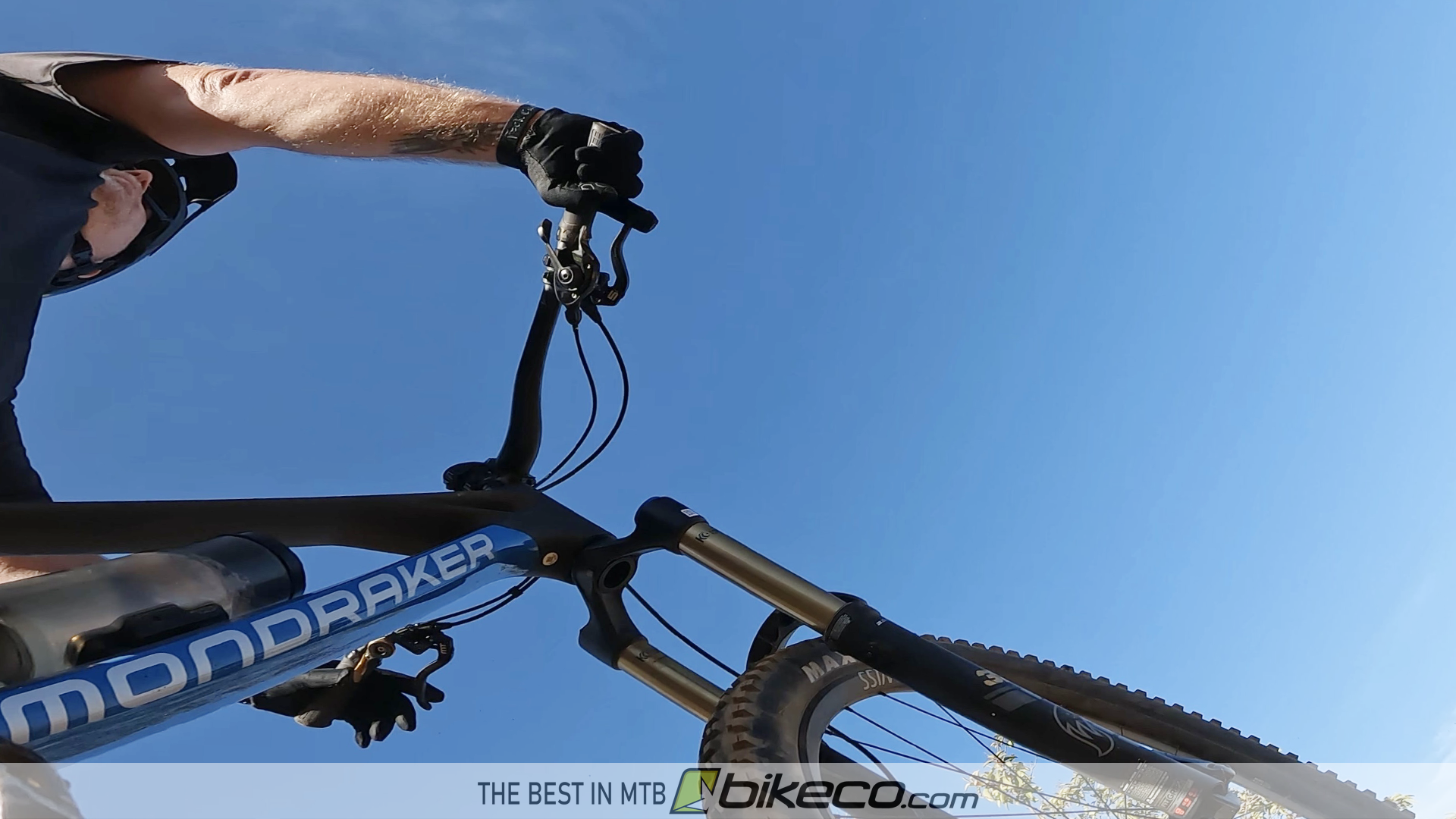


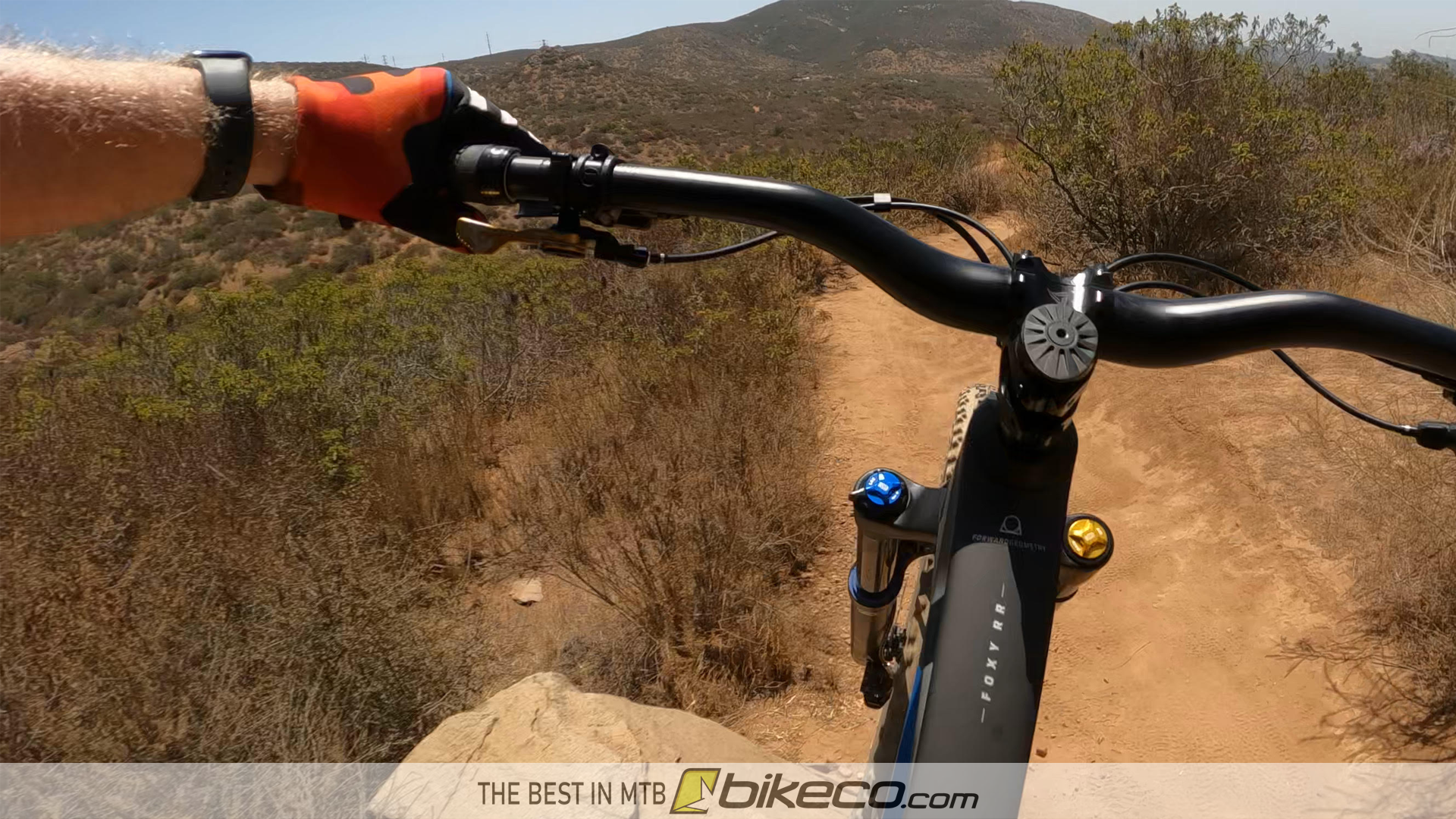
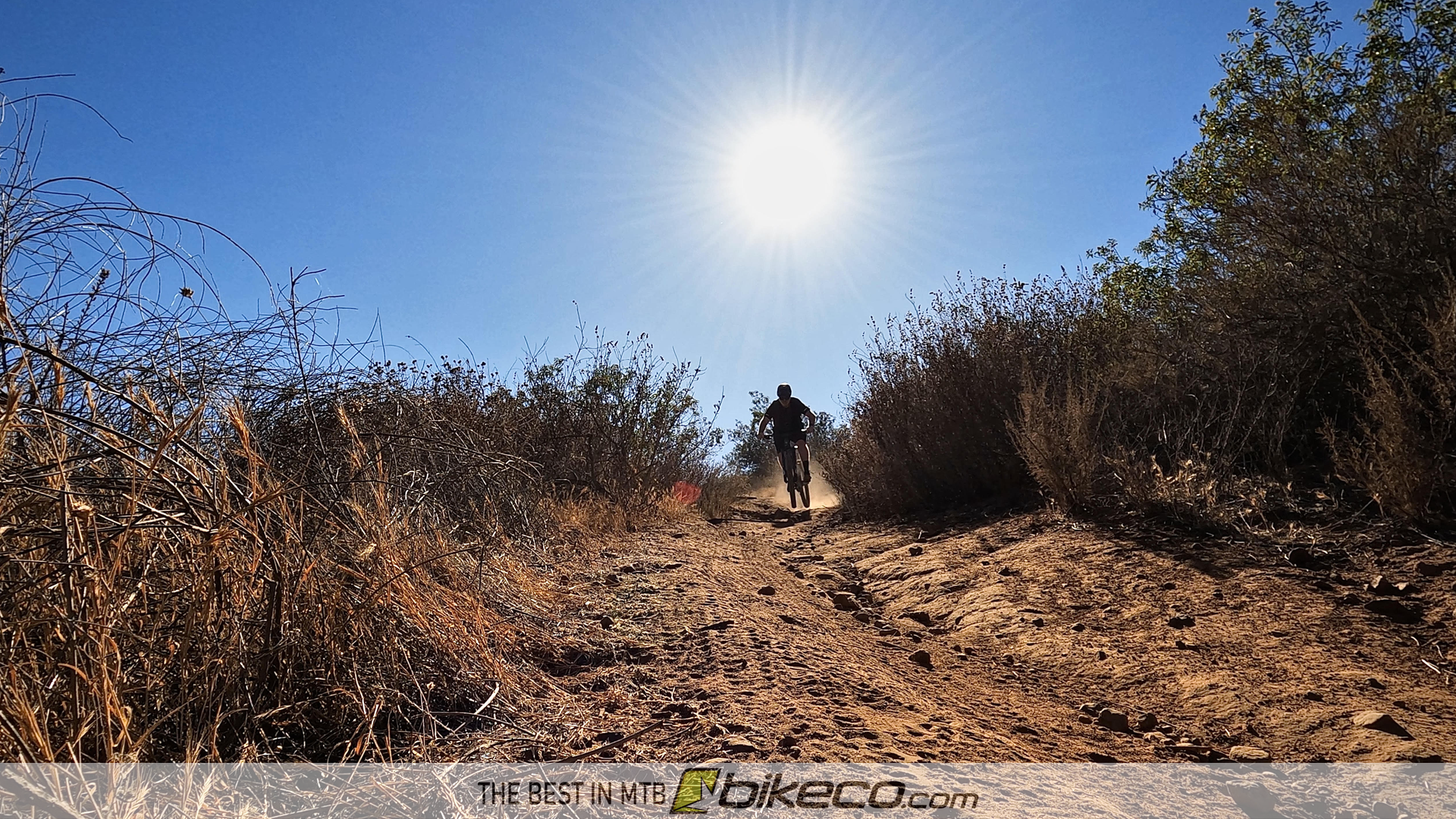
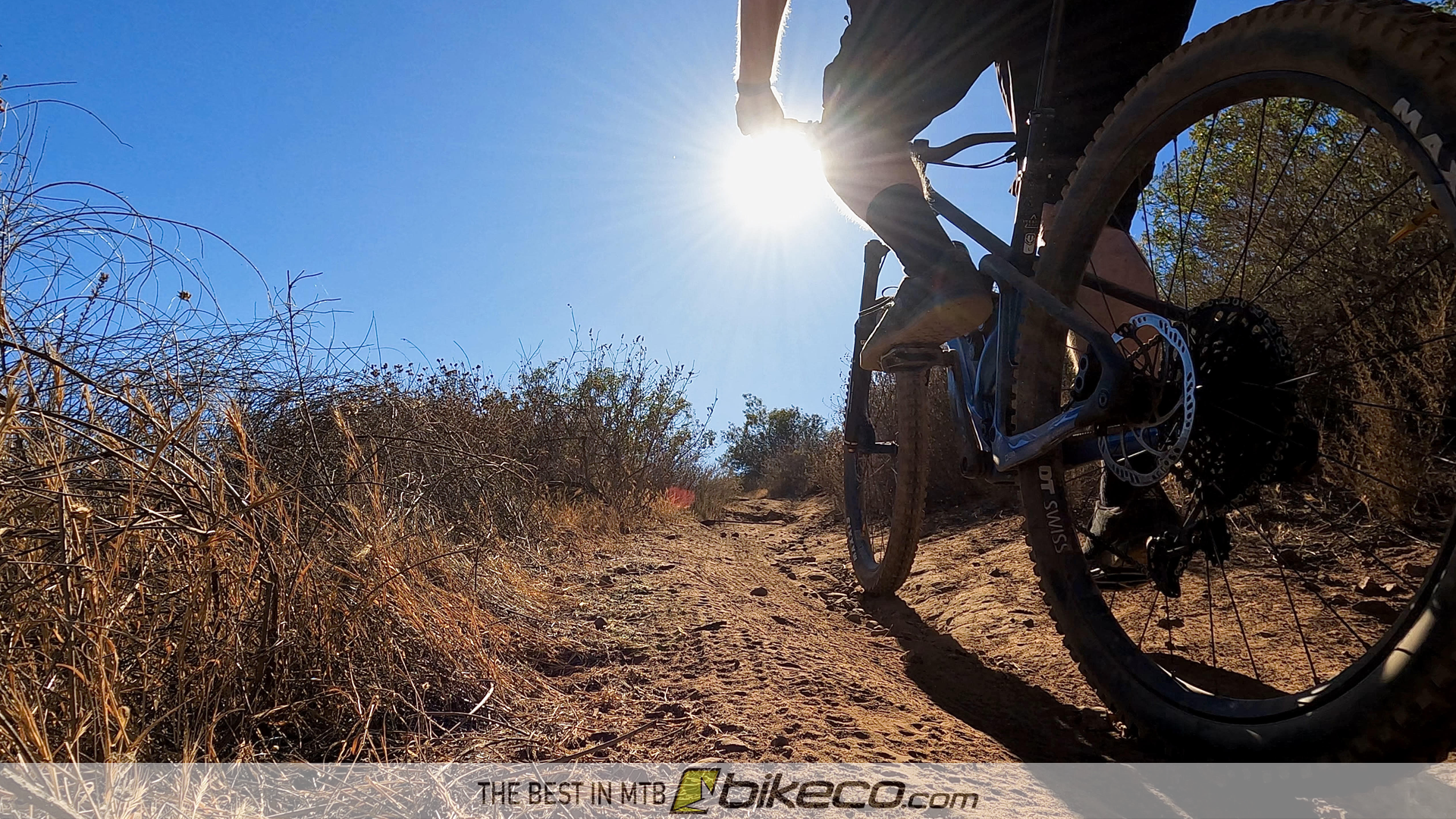
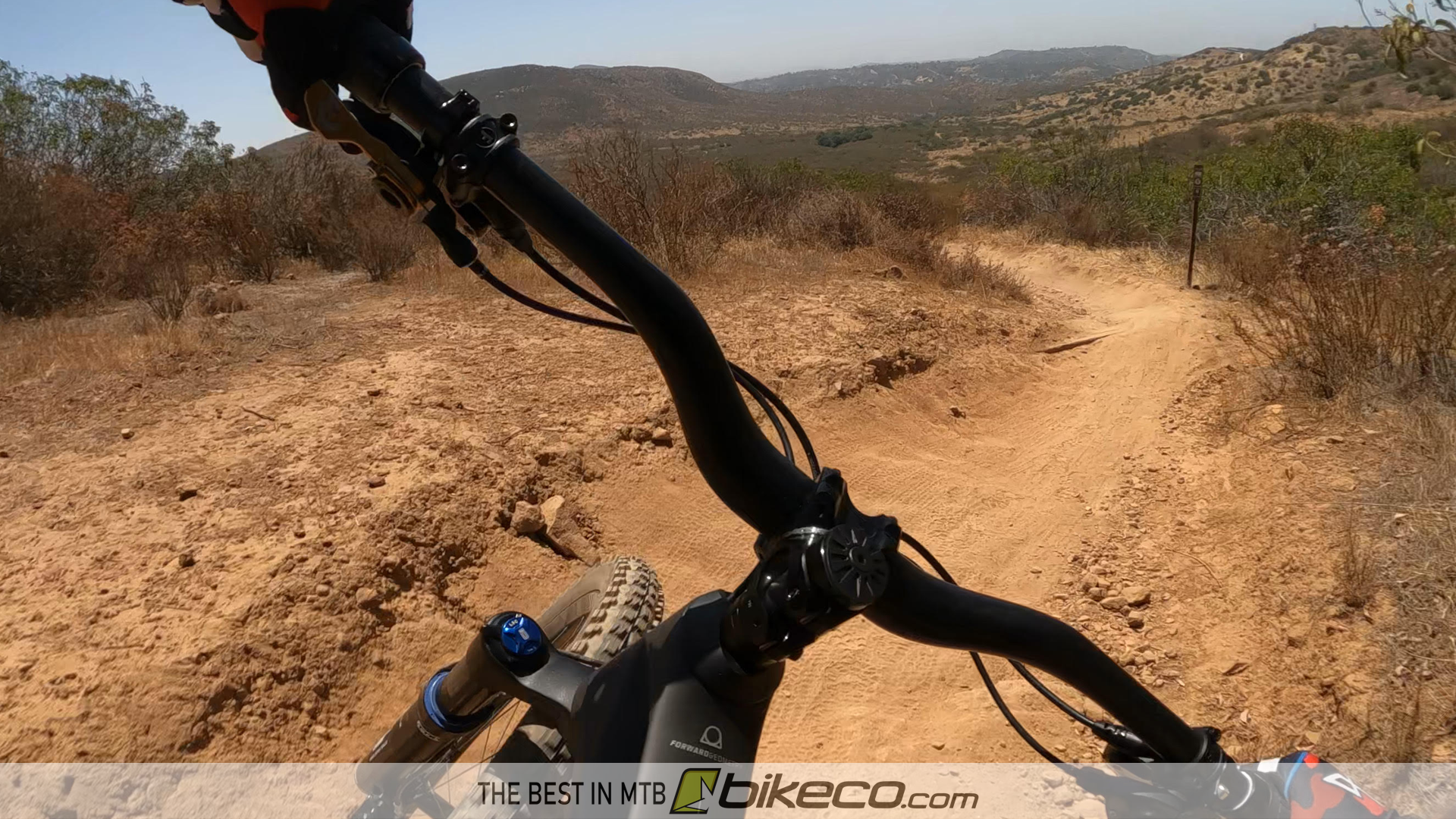


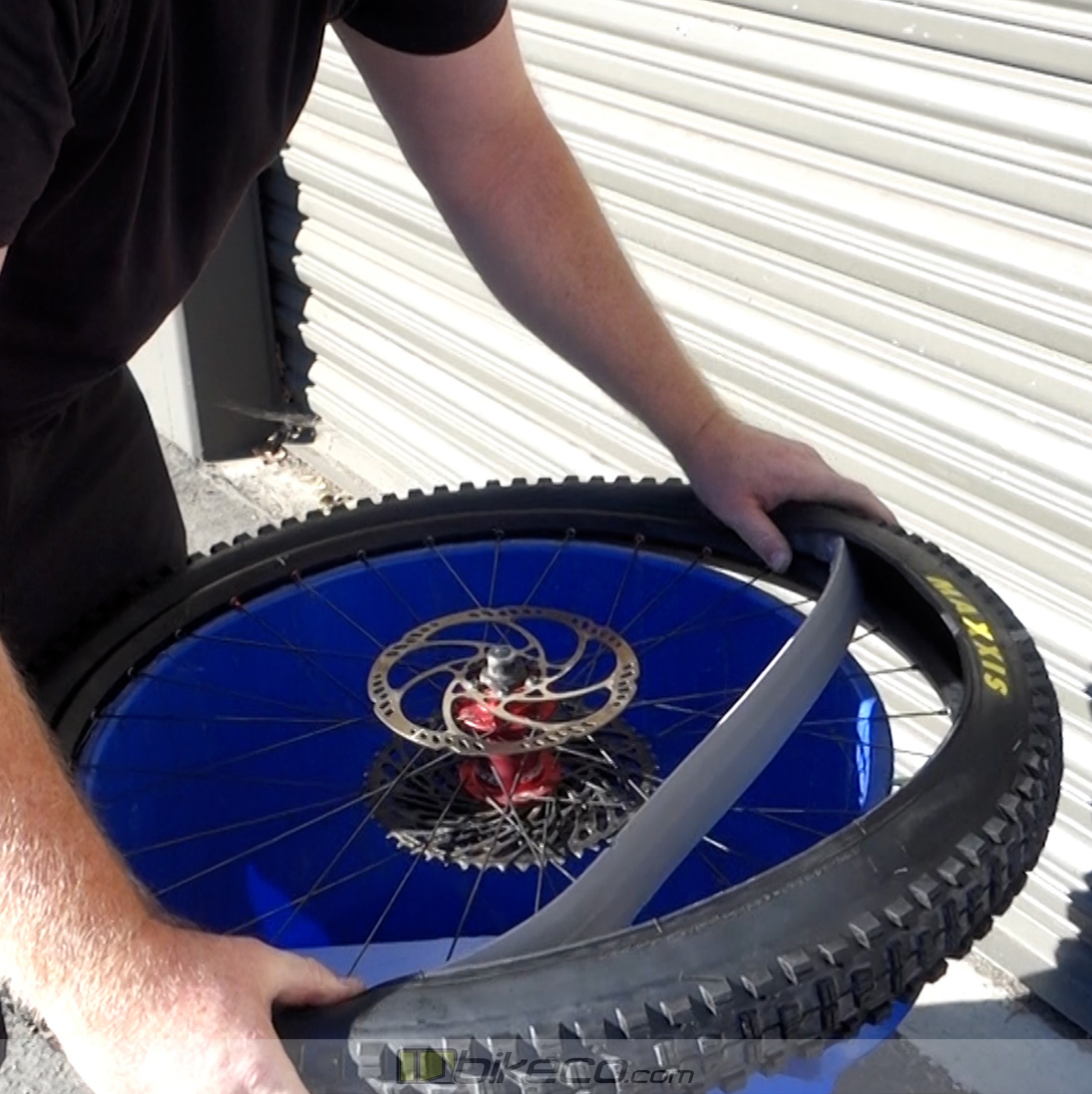

 Just a little low on the PSI for my taste. The X markings have me increase pressure about 2 PSI.
Just a little low on the PSI for my taste. The X markings have me increase pressure about 2 PSI.




